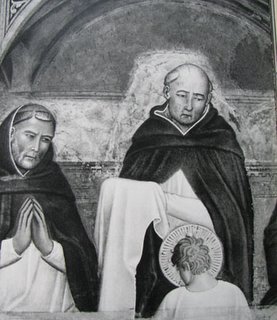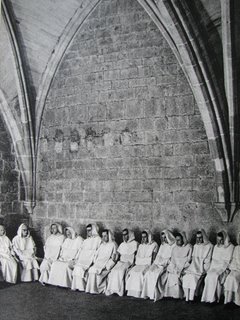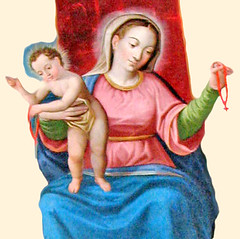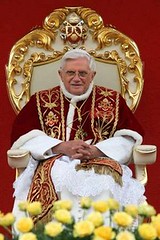Blessed Jordan of Saxony (Part Two)
 Biographical Sketch
Biographical SketchNot very much of Blessed Jordan’s life is known before he came into contact with the Order but we can surmise that he was born no later than 1190 (and possibly earlier) at Padburg near Marsburg in Westphalia. He was probably born into a feudal (noble) family and about the year 1210 he went to Paris, where he studied grammar, philosophy and mathematics, and more especially, theology and sacred scripture. Of languages, we know he spoke German and Latin but no French!
We don’t have any record of what he looked like but the Vitae Fratrum mentions his short-sightedness and later mentions that because of “a very severe sickness” (which Aron calls “marsh-fever”) he went blind in one eye. Jordan himself mentions this in a letter to Diana in 1234: “I am suffering much with one of my eyes and am in danger of losing it.” Of his character, Gerald Vann OP notes: “There is one adjective in particular… that become indissolubly linked with his name: it is dulcis, gentle, sweet-natured. He was a man of manifold gifts; but his sweetness and charm seemed to colour his other gifts, and to be the secret of his amazing success in his work for souls.” The Vitae Fratrum tells us that he “tried to correct faults more by winning gentleness and trusting his subjects than by harsh discipline, although he knew how to use this means as well but always having regard to time and place and persons.”
In 1217, Jordan himself tells us that he saw the Dominicans arrive in Paris (on Sept 12) and he began his association with the friars Preachers. In 1218 and 1219, while he was still a student at the university of Paris he used to rise every night for Matins. Aron suggests that he must have been a member of the Confraternity of ‘Parisians who get up to say Matins’ which was founded in 1205 and consisted of pious men who followed the canons in their religious practice and was probably drawn from students of theology. In recounting Jordan’s practice of this, the Vitae Fratrum observes that Jordan was a man of great piety who had a particular love for the poor and he frequently gave to the beggars of Paris even if that meant that he had to go without.
In 1220, he was already a Master of Arts, a Bachelor of Theology and a sub-deacon. In January of that year (1220) Bl Jordan heard the preaching of Bl Reginald of Orleans. Bl Reginald had only arrived at St Jacques Priory in Paris the month before (Dec 1219) and he was a former Regent-Master of Canon Law at Paris University, so he may already have been acquainted with Jordan. Bl Reginald (to whom Our Lady is believed to have appeared with a vision of the Dominican habit) admitted Bl Jordan into the Order. Together with Henry of Cologne and a Bro Leo, Bl Jordan received the habit on Ash Wednesday, 12 February 1220. Jordan was particularly close to Henry and in the Libellus he writes: “I recall seeing none in this life more gracious than Brother Henry, a true vessel of honor and of grace whom I hold dearer than any other mortal.”
Bl Reginald died shortly after Jordan entered the Order and Aron says that the “friars of St Jacques and the students of Paris saw in Jordan, in his first sermons, the successor of Reginald and the providential continuer of his work. Like Reginald, rapid and convincing, he went straight to the heart of things, to the depth of souls” and indeed there is a link here in the intellectual strength of the Order: ‘Reginaldus genuit Jordanum – Jordanus genuit Albertum Magnum – Albertus genuit Thomam Aquinitatis.’ Aron goes on to say that Jordan “has the gift, rare among intellectuals, of perfect naturalness which being without formality frees the sentiments and emotions. It was doubtless by his open-heartedness, no less than by the authority of his knowledge, that he remained even in his old age so close to young men, so beloved by them and so truly his friend.”
These eminent qualities of Bl Jordan were recognized not only by Bl Reginald but clearly by St Dominic himself for scarcely 2 months after his vestition, he was sent, with three others, to Bologna for the General Chapter of 1220, as diffinitors (representatives) of the Priory of St Jacques. The Chapter was opened on Pentecost day, May 17, 1220. It was at this Chapter that the Order renounced all possessions, put off the canon’s rochet and took up the scapular with hood and abolished the title of Abbot, which Matthew of France held for a short while.
In June 1221, Bl Jordan was elected Provincial of Lombardy. This Province had 10 houses and was fighting the Vaudois (Waldensian) heresy. This was clearly a burden laid upon him and in the Libellus he writes: “The general chapter at Bologna appointed me first prior of the Lombardy Province, even though I had been in the Order only one year and my roots were not so firmly planted as they should have been, for I ought to have learned to rule my own imperfection before being set over others.” But we also see his sense of humility, obedience and self-awareness. Nevertheless, he goes to Bologna (the main city in Lombardy) in July 1221 and leaves the company of his dear friend, Henry and the familiarity of Paris.
As an aside, Henry became Prior of Cologne in 1221 but died tragically young in October 1225 in the arms of Bl Jordan. Jordan’s grief still resonates today. To a Benedictine nun, he wrote: “See, most dear, how God has afflicted me in a sudden and unforeseen way…” and he writes movingly about him in a “digression” in the Libellus. Coming back to the year 1221…
That same 1221 General Chapter in Bologna also sent 13 friars to England where they settled in Oxford on 15 August; as it happened, just 9 days after the death of St Dominic who had been buried at the (then) church of St Nicholas of the Vineyards in Bologna.
The next General Chapter convened on Pentecost, 22 May 1222 in Paris and Bl Jordan again travels the route from Bologna to Paris, a distance of some 900 miles on foot taking about 7 weeks. He was unanimously elected as the successor to St Dominic and the Second Master General of the Order. This is a high commendation indeed if we consider that many of St Dominic’s first followers were still living. They clearly saw in him great potential and Guy Bedouelle OP suggests that Jordan was deliberately chosen by St Dominic. In fact he says that Dominic in his wisdom must have been looking for a successor and clearly chose well because the Order grew enormously under Bl Jordan’s charge. He contrasts this with the difficulties the Franciscans had in finding a successor for St Francis. Thus Hinnebusch says: “A successor of other temperament could easily have wrecked Dominic’s work and changed the character of the Order. Jordan entered completely into the mind of his predecessor and had fifteen active years to build on the foundations.”

Between 1217 and 1222, the Order had established 40 priories in 8 Provinces. It was these that Jordan took charge of. He was to increase the Order’s size exponentially so that by his death there were nearly 300 priories and several thousand friars. By 1277 there were 404 priories in Provinces including a Province in the Holy Land which was then under Crusader control. In 1256, it is believed that the Order had 13,000 friars or whom 10,000 were priests. Although these statistics are for years after his death, we can surmise that he contributed greatly to this increase.
It was noted by a contemporary of Bl Jordan’s that “it was his supreme desire to spread the Order for the benefit of souls. For that reason he devoted himself entirely to attracting good men to the Order and consequently used to spend almost all of his time in place where there were students, especially in Paris.” Indeed in his letters to Bl Diana, Jordan writes of the numbers of novices he attracted in a matter of weeks, up to 40 at a time! His zeal for recruits is expressed in a letter from Oxford where he tells Bl Diana of his hopes for “a good catch”… It is estimated that in his lifetime he drew 1000 novices to the Order, which suggests what a charismatic and attractive person he was! No wonder then that he is Patron of Dominican vocations. The most noteworthy of his ‘conquests’ was Albert the Great, who took the habit in Padua in 1223.
As Master General, Bl Jordan established the convent of St Agnes in Bologna, which we have seen he had a great love and care for and in particular he had a spiritual intimacy with Bl Diana. He presided over all the General Chapters held during his years in office except those of 1234 and 1235, when sickness kept him away. Under his leadership the Chapters completed the governmental structure of the Order and extended its apostolate into many new fields. In the intervals between Chapters, Jordan travelled extensively, bringing his personal direction to even the most distant Provinces, such as England and Palestine. In 1225 he presided at the first Provincial Chapter of the German Province in Magdeburg and in 1230 he did the same for the English Dominicans in Oxford and he preached the Lenten sermons in the University and then toured the English Province, conducting a preaching campaign. Four Provinces at least were added during his Generalship: Poland, Greece, Dacia and the Holy Land.
The Vitae Fratrum says that Blessed Jordan had “feelings of the tenderest devotion for the blessed Virgin” and this is clearly seen in the Libellus. Jordan himself mentions how the Dominican tradition of the Salve Procession was instituted by him on account of demonic attacks on a Brother Bernard. He writes in the Libellus:
“This cruel harassment of Brother Bernard was the first occasion that moved us to establish the custom of singing the ‘Salve Regina’ after compline at Bologna. From there the practice spread through the province of Lombardy and eventually became general throughout the Order. How many tears of devotion have sprung from this holy praise of God's venerable Mother? How many hearts of those who sang or listened has it not melted, how often has it not softened bitterness and installed fervor in its place? Do we believe that the Mother of our Redeemer is pleased with such praises and moved by such cries? A certain man, both religious and trustworthy, has told me that, in spirit, he often saw the Mother of our Lord prostrate before her Son praying for the security of the whole Order, as the friars were singing: "Turn, then, most gracious advocate, thine eyes of mercy toward us." I mention this so that the brethren reading it may be inspired to even greater devotion in praising the Virgin.”Indeed, Bl Jordan’s words have often inspired me as we sing the Salve every night.
On 4 August 1234, when he was in Strasbourg, Jordan received news of St Dominic’s canonization and he shares this joy with Bl Diana in a letter. On 10 June 1236, Bl Diana died at the age of about 35 in Bologna. The following year, Bl Jordan travelled to the new Province in the Holy Land on a visitation. Upon completion of this he boarded a ship bound for Naples with two brothers. On 13 February 1237, a violent storm hit the ship and 29 people on-board tragically drowned along with Blessed Jordan of Saxony and his companions. His body washed ashore, whereupon “great lights from heaven” shone upon their bodies and there came an “exceedingly sweet fragrance” from their bodies. Finally the brethren from the Priory of St Jean d’Acre came and carried their bodies away where he was buried in the Priory which had only been founded in 1229. Sadly this Priory was destroyed shortly after by the Turks and the tomb of Bl Jordan and his relics were never recovered.
In 1827 he was finally beatified but only by concession to common usage, as he was already regarded as a saint by popular acclaim.
Images above are from 'St Dominic' by Leonard Von Matt & Marie-Humbert Vicaire OP (1957)
Continued tomorrow: Traits in Jordan's Spirituality







0 Comments:
Post a Comment
<< Home